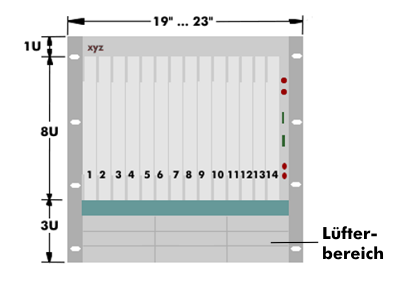shelf
Subracks are used in industrial, scientific and commercial applications to hold, power and connect single board computers, carrier boards and other plug-in assemblies.
Subracks are enclosures, equipped with backplanes, that operate as stand-alones or are built into racks. They have guide rails into which the subassemblies with the printed circuit boards are inserted. The boards are supplied and connected via the backplane, which is equipped with the connectors and also contains the bus systems.
Subracks are standardized by the European Telecommunications Standards Institute( ETSI) and designed for specific board sizes. The width for rack mounting in 19" racks is 84 pitch units( HP). One pitch unit corresponds to 1/5", i.e. 5.08 mm. The height of the subracks is specified in height units(HE) - one height unit corresponds to 44.45 mm - and can be designed for different board formats such as the Eurocard. The installation dimension for subracks matched for 3 U is 100 mm and not 133.35 mm. Larger plug-in modules with 6 U or 9 U are each 133.35 mm taller. Thus 6 U has a height of 233.35 mm (100 mm plus 133.35 mm) and 9 U has a height of 366.70 mm. The depth of the subracks depends on the size of the PCB, which is 160 mm, 220 mm and 280 mm.
The subracks are inserted into the rails and connected to the bus, supply voltage and other signals via the backplane connectors. Subracks are specified in IEC 60297.

